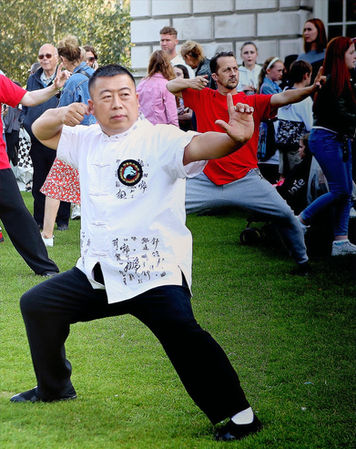Z.C.H.I.W.A.

Zhu Chang Hai International Wushu Association

Styles
Martial Arts
Tai Ji Quan (Tai Chi)
Qigong
Yang Style
Tai Ji Quan (Tai Chi)
Yang Style is the most practiced Tai Chi style today. The large frames strongly emphasise posture, rooting and yielding. The foundation form is slow, calm, steady and expansive. Pronominally performed at a constant speed with only the spins and some of the kicks being fast.
Yang Style was founded by Yan Lu Chan (1799-1872) who studied Tai JI Quan (Tai Chi) in the Chen Village with master Chen Chang Xing. While travelling around China he gained great reputation for his skills and was hired to be an appointed Martial Arts Instructor to the Imperial Banner Battalion.
His grandson, Yang Cheng Fu was the first Tai Ji Quan (Tai Chi) master willing to share the family secrets with the public. Because of his gentle nature he had countless students.
Chen Style
Tai Ji Quan (Tai Chi)
Chen Style is characterised by slow, graceful movements mixed with explosive ones (Fa Jin) including jumps, kicks and strikes. Silk reeling (Chan Si)– spiral movements that flow from the feet to the hands are the foundation of Chen style Tai Ji Quan (Tai Chi). Like iron wrapped in cotton, the movements are soft on the outside but hard and powerful on the inside.
Chen Style was founded by Chen Wang Ting (1600-1680), a famous General and martial artist of the Ming period. It was created by combining ideas of Qigong, martial arts, traditional Chinese medicine and the Daoist philosophy of Yin and Yang.
Qigong
Baduanjin (8 Piece Brocade)
It is one of the most spread ancient Daoyin practises of China. It uses callisthenics, stretching and breathing exercises to maintain good health, fight disease and enhance the quality of life. It increases lung capacity, builds strength, flexibility, mobility, coordination, balance, helps relaxation, reduces stress and anxiety and boosts immunity.
6 Healing Sounds
This Qigong set involves coordination of movement and breathing patterns with specific sounds. It is strengthening the internal functions of the body and preventing diseases. Each sound is associated with a different gesture, organ, colour, season and emotions. By focusing on your breathing, posture, visualisation and tapping into the vibration of each healing sound you can relax, release stress and transform negative emotions into positive.
13 Tai Bao
"Thirteen Tai Bao" plays a big role in strengthening the body and prolonging life.
From young people to the elderly, through the practice of thirteen specific Qigong movements of this exercise, they can strengthen muscles and bones, enhance physical fitness and internal strength, increase lung capacity, support heart, spleen and kidneys function.
Wuqin Xi
Five Animals Game uses an imitation of tiger, deer, bear, monkey and bird. It was created by a famous physician Hua Tue (ce 140-208) to eliminate sickness and strengthen the root. The Five animals set is closely aliened with the Five Elements Theory of Chinese medicine. The practice of this exercise should include a spiritual essence of the animal embodying their qualities in the physical movement.
Zhan Zhuang
Standing meditation makes use of static postures to deeply release long-held stress and tension. The legs, spine and shoulders become very strong yet relaxed. Unnecessary tension is released from the joints and the muscles making them more flexible and elastic.
Zhan Zhuang makes use of specific relaxed abdominal breathing, mental imagery and awareness of the inside of your body.



